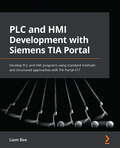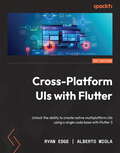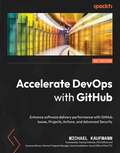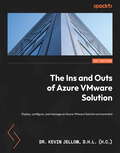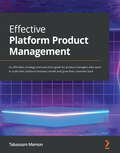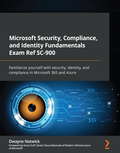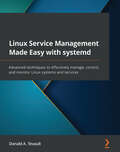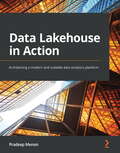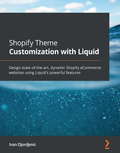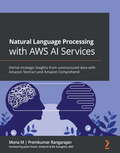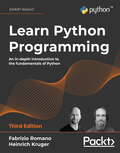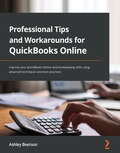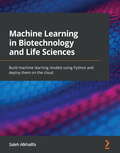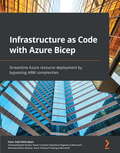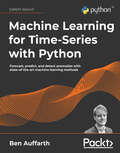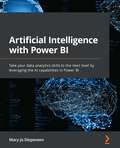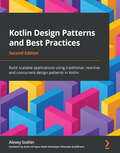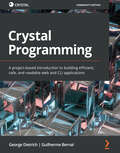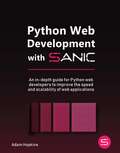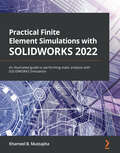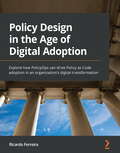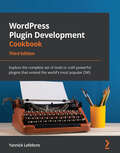- Table View
- List View
PLC and HMI Development with Siemens TIA Portal: Develop PLC and HMI programs using standard methods and structured approaches with TIA Portal V17
by Liam BeeBecome well-versed with the tools available in the Siemens TIA toolbox and write PLC and HMI code effectivelyKey FeaturesFind out how to use TIA Portal effectively to boost your productivityLearn about a structured design pattern and understand why it is so powerful when implemented correctlyDiscover efficient project management and design practicesBook DescriptionWith automation requirements on the rise, Siemens' TIA Portal development environment is almost a necessity for any automation engineer. The Totally Integrated Automation (TIA) environment helps seamlessly integrate all things automation, from PLC hardware and software design to HMI development. This book helps you understand the tools available in the TIA toolbox and shows you how to write code effectively.The book begins by introducing you to the TIA environment, covering the layout and tools available. Once you've got to grips with the environment, you'll find out how to create hardware to write programs against, including adding IO modules and assigning memory for input and output. Next, you'll develop logic in all of the languages that TIA Portal offers, such as Ladder, Function Block Diagram, and Structured Text (SCL) (note that Statement List is not covered as a deprecated language), as well as the newest language, Cause and Effect (CEM). You'll also discover how to store standard code in libraries, creating a version control system that is easy to manage and aids standard design. Finally, following the PLC design chapters, you'll learn how to develop HMI applications in TIA Portal's latest unified hardware.By the end of the book, you'll be well equipped to use all of the features that TIA Portal V17 offers.What you will learnSet up a Siemens Environment with TIA PortalFind out how to structure a projectCarry out the simulation of a project, enhancing this further with structureDevelop HMI screens that interact with PLC dataMake the best use of all available languagesLeverage TIA Portal's tools to manage the deployment and modification of projectsWho this book is forThis TIA Portal book is for anybody looking to learn PLC/HMI development using the latest Siemens development platform. Industrial software engineers, PLC engineers, automation engineers, and electricians will be able to advance their skill set with this guide. A basic understanding of PLC principles such as PLC data types and basic objects such as function blocks and functions is necessary to get started.
Cross-Platform UIs with Flutter: Unlock the ability to create native multiplatform UIs using a single code base with Flutter 3
by Ryan Edge Alberto MiolaBuild a variety of dynamic projects and beautiful UIs as you explore the power of Flutter for the web, desktop, and mobileKey FeaturesDiscover state management solutions with InheritedWidget and the Provider packageCreate responsive and beautiful UIs with the Material and Cupertino librariesExplore animations, forms, gestures, and backend integration with SupabaseBook DescriptionFlutter is a UI toolkit for building beautiful, natively compiled applications for mobile, web, desktop, and embedded devices from a single code base. With Flutter, you can write your code once and run it anywhere using a single code base to target multiple platforms. This book is a comprehensive, project-based guide for new and emerging Flutter developers that will help empower you to build bulletproof applications.Once you start reading book, you'll quickly realize what sets Flutter apart from its competition and establish some of the fundamentals of the toolkit. As you work on various project applications, you'll understand just how easy Flutter is to use for building stunning UIs. This book covers navigation strategies, state management, advanced animation handling, and the two main UI design styles: Material and Cupertino. It'll help you extend your knowledge with good code practices, UI testing strategies, and CI setup to constantly keep your repository's quality at the highest level possible.By the end of this book, you'll feel confident in your ability to transfer the lessons from the example projects and build your own Flutter applications for any platform you wish.What you will learnCreate responsive and attractive UIs for any deviceGet to grips with caching and widget trees and learn some framework performance tipsManage state using Flutter's InheritedWidget systemOrchestrate the app flow with Navigator 1.0 and 2.0Explore the Material and Cupertino built-in themesBreathe life into your apps with animationsImprove code quality with golden tests, CI setup, and linter rulesWho this book is forThis book is for software developers with a good grasp of Flutter, who want to learn best practices and techniques for building clean, intuitive UIs using a single codebase for mobile and the web. Prior experience with Flutter, Dart, and object-oriented programming (OOP) will help you understand the concepts covered in the book.
Accelerate DevOps with GitHub: Enhance software delivery performance with GitHub Issues, Projects, Actions, and Advanced Security
by Michael Kaufmann Thomas Dohmke Donovan BrownTake your DevOps and DevSecOps game to the next level by leveraging the power of the GitHub toolset in practiceKey FeaturesRelease software faster and with confidenceIncrease your productivity by spending more time on software delivery and less on fixing bugs and administrative tasksDeliver high-quality software that is more stable, scalable, and secureBook DescriptionThis practical guide to DevOps uses GitHub as the DevOps platform and shows how you can leverage the power of GitHub for collaboration, lean management, and secure and fast software delivery. The chapters provide simple solutions to common problems, thereby helping teams that are already on their DevOps journey to further advance into DevOps and speed up their software delivery performance. From finding the right metrics to measure your success to learning from other teams' success stories without merely copying what they've done, this book has it all in one place. As you advance, you'll find out how you can leverage the power of GitHub to accelerate your value delivery – by making work visible with GitHub Projects, measuring the right metrics with GitHub Insights, using solid and proven engineering practices with GitHub Actions and Advanced Security, and moving to event-based and loosely coupled software architecture. By the end of this GitHub book, you'll have understood what factors influence software delivery performance and how you can measure your capabilities, thus realizing where you stand in your journey and how you can move forward.What you will learnEffectively measure software delivery performanceAdopt DevOps and lean management techniques in your teamsPlan, track, and visualize your work using GitHub Issues and ProjectsUse continuous delivery with GitHub Actions and PackagesScale quality through testing in production and chaos engineering“Shift left” security and secure your entire software supply chainUse DevSecOps practices with GitHub Advanced SecuritySecure your code with code scanning, secret scanning, and DependabotWho this book is forThis book is for developers, solutions architects, DevOps engineers, and SREs, as well as for engineering or product managers who want to enhance their software delivery performance. Whether you're new to DevOps, already have experience with GitHub Enterprise, or come from a platform such as Azure DevOps, Team Foundation Server, GitLab, Bitbucket, Puppet, Chef, or Jenkins but struggle to achieve maximum performance, you'll find this book beneficial.
The Ins and Outs of Azure VMware Solution: Deploy, configure, and manage an Azure VMware Solution environment
by D.H.L. (h.c.) JellowManage VMware workloads in Azure VMware Solution and enable hybrid connectivity between on-premises datacenters and Azure with this extensive guide focusing on best practices and use casesKey FeaturesExtend or migrate your existing VMware environment to Azure VMware Solution smoothlyDiscover best practices that are based on real customer experiencesJoin the cloud revolution by conducting the most suitable migration for your workloadsBook DescriptionOrganizations over the world are migrating partially or fully to the cloud, but with the whole slew of providers, tools, and platforms available, knowing where to start can be quite challenging. If you know Microsoft Azure VMware Solution, you know it is the quickest way to migrate to the cloud without needing application modernization or rework. You can retain the same VMware tools to manage your environment while moving to Azure. But how does it work? The Ins and Outs of Azure VMware Solution has the answer.This high-level, comprehensive yet concise guide to Azure VMware Solution starts by taking you through the architecture and its applicable use cases. It will help you hit the ground running by getting straight to the important steps: planning, deploying, configuring, and managing your Azure VMware Solution instance. You'll be able to extend your existing knowledge of Azure and VMware by covering advanced topics such as SRM and governance, setting up a hybrid connection to your on-premises datacenter, and scaling up using disk pools.By the end of the VMware book, you'll have gone over everything you need to transition to the cloud with ease using Azure VMware Solution.What you will learnGet to grips with the overall architecture of Azure VMware SolutionDiscover Enterprise-scale for Azure VMware SolutionDeploy an Azure VMware private cloud successfullyDeploy and configure HCX in Azure VMware SolutionConfigure NSX-T network segments with the NSX-T ManagerConfigure internet access, traffic inspection, and storage for AVSIntegrate Azure VMware Solution with Azure-native servicesUse governance to improve your cloud portfolioWho this book is forThis book is for VMware administrators, cloud solutions architects, and anyone interested in learning how to deploy and configure an AVS environment in Azure. Technology leaders who want to get out of the datacenter business or expand their on-premises datacenter into Microsoft Azure will also find this book useful. Familiarity with VMware solutions and a basic understanding of Azure networking is necessary to get started with this book.
Effective Platform Product Management: A product manager's guide to strategizing and executing the platform business model to expand the customer base
by Tabassum MemonDesign, strategize, and implement a proven roadmap for your platforms to scale your business across multiple channels that provide a seamless and intuitive user experienceKey FeaturesUnderstand the importance of platform business models and the difference between linear products and platformsExplore the end-to-end platform life cycle, from developing a strategy to measuring the outcomeDiscover the benefits of the platform business model and effective strategies through examplesBook DescriptionIn recent years, platform business models have revolutionized various industries, including retail and media. Companies such as Amazon, Netflix, and Spotify have changed how businesses reach out to their consumers. With the rise of these platforms and the increased use of technology, consumers prefer to search, explore, compare, and choose between different options within a single uninterrupted user experience. Providing such an experience is difficult and almost impossible when using linear models, and this is why modern businesses must adopt a platform-first approach to change how they invent, develop, and market solutions. This book addresses a critical pillar of platform development – product management. It'll help you to understand the difference between traditional and modern product management for platforms while exploring the importance and benefits of the platform business model. As you progress, you'll be able to build the right platform strategy, define the MVP, and focus on ongoing backlog prioritization for successful platforms. This book also walks you through the steps and guidelines that'll help organizations and product managers to transition from linear products to platforms. By the end of this platform product management book, you'll have learned the essential aspects of product management for building successful and scalable platforms.What you will learnUnderstand the difference between the product and platform business modelBuild an end-to-end platform strategy from scratchTranslate the platform strategy to a roadmap with a well-defined implementation planDefine the MVP for faster releases and test viability in the early stagesCreate an operating model and design an execution planMeasure the success or failure of the platform and make iterations after feedbackWho this book is forThis book is for product managers, product owners, product directors, and business executives responsible for defining platform strategy and its day-to-day execution. The book will also be useful for change managers and program managers who are responsible for the transition from products to platforms. No prior knowledge of platform strategy or platform transitioning is required as the book covers these topics to help you get started.
Microsoft Security, Compliance, and Identity Fundamentals Exam Ref SC-900: Familiarize yourself with security, identity, and compliance in Microsoft 365 and Azure
by Dwayne Natwick Sonia CuffUnderstand the fundamentals of security, compliance, and identity solutions across Microsoft Azure, Microsoft 365, and related cloud-based Microsoft servicesKey FeaturesGrasp Azure AD services and identity principles, secure authentication, and access managementUnderstand threat protection with Microsoft 365 Defender and Microsoft Defender for Cloud security managementLearn about security capabilities in Microsoft Sentinel, Microsoft 365 Defender, and Microsoft IntuneBook DescriptionCloud technologies have made building a defense-in-depth security strategy of paramount importance. Without proper planning and discipline in deploying the security posture across Microsoft 365 and Azure, you are compromising your infrastructure and data. Microsoft Security, Compliance, and Identity Fundamentals is a comprehensive guide that covers all of the exam objectives for the SC-900 exam while walking you through the core security services available for Microsoft 365 and Azure.This book starts by simplifying the concepts of security, compliance, and identity before helping you get to grips with Azure Active Directory, covering the capabilities of Microsoft's identity and access management (IAM) solutions. You'll then advance to compliance center, information protection, and governance in Microsoft 365. You'll find out all you need to know about the services available within Azure and Microsoft 365 for building a defense-in-depth security posture, and finally become familiar with Microsoft's compliance monitoring capabilities.By the end of the book, you'll have gained the knowledge you need to take the SC-900 certification exam and implement solutions in real-life scenarios.What you will learnBecome well-versed with security, compliance, and identity principlesExplore the authentication, access control, and identity management capabilities of Azure Active DirectoryUnderstand the identity protection and governance aspects of Azure and Microsoft 365Get to grips with the basic security capabilities for networks, VMs, and dataDiscover security management through Microsoft Defender for CloudWork with Microsoft Sentinel and Microsoft 365 DefenderDeal with compliance, governance, and risk in Microsoft 365 and AzureWho this book is forThis book is for cloud security engineers, Microsoft 365 administrators, Azure administrators, and anyone in between who wants to get up to speed with the security, compliance, and identity fundamentals to achieve the SC-900 certification. A basic understanding of the fundamental services within Microsoft 365 and Azure will be helpful but not essential.
Linux Service Management Made Easy with systemd: Advanced techniques to effectively manage, control, and monitor Linux systems and services
by Donald A. TevaultA comprehensive guide for teaching system administrators, developers, and security professionals how to create their own systemd units and maintain system securityKey FeaturesMaintain and troubleshoot systemd services with easeLearn to create, modify, and reload service files and use systemd utilitiesUse cgroups to control resource usage and enhance securityBook DescriptionLinux Service Management Made Easy with systemd will provide you with an in-depth understanding of systemd, so that you can set up your servers securely and efficiently.This is a comprehensive guide for Linux administrators that will help you get the best of systemd, starting with an explanation of the fundamentals of systemd management.You'll also learn how to edit and create your own systemd units, which will be particularly helpful if you need to create custom services or timers and add features or security to an existing service.Next, you'll find out how to analyze and fix boot-up challenges and set system parameters. An overview of cgroups that'll help you control system resource usage for both processes and users will also be covered, alongside a practical demonstration on how cgroups are structured, spotting the differences between cgroups Version 1 and 2, and how to set resource limits on both.Finally, you'll learn about the systemd way of performing time-keeping, networking, logging, and login management. You'll discover how to configure servers accurately and gather system information to analyze system security and performance.By the end of this Linux book, you'll be able to efficiently manage all aspects of a server running the systemd init system.What you will learnUse basic systemd utilities to manage a systemCreate and edit your own systemd unitsCreate services for Podman-Docker containersEnhance system security by adding security-related parametersFind important information with journaldAnalyze boot-up problemsConfigure system settings with systemd utilitiesWho this book is forThis book is best suited for Linux administrators who want to learn more about maintaining and troubleshooting Linux servers. It will also be useful for aspiring administrators studying for a Linux certification exam, developers looking to learn how to create systemd unit files, and security administrators who want to understand the security settings that can be used in systemd units and how to control resource usage with cgroups. Before you dive into this book, you'll need a solid working knowledge of basic Linux commands.
Data Lakehouse in Action: Architecting a modern and scalable data analytics platform
by Pradeep MenonPropose a new scalable data architecture paradigm, Data Lakehouse, that addresses the limitations of current data architecture patternsKey FeaturesUnderstand how data is ingested, stored, served, governed, and secured for enabling data analyticsExplore a practical way to implement Data Lakehouse using cloud computing platforms like AzureCombine multiple architectural patterns based on an organization's needs and maturity levelBook DescriptionThe Data Lakehouse architecture is a new paradigm that enables large-scale analytics. This book will guide you in developing data architecture in the right way to ensure your organization's success.The first part of the book discusses the different data architectural patterns used in the past and the need for a new architectural paradigm, as well as the drivers that have caused this change. It covers the principles that govern the target architecture, the components that form the Data Lakehouse architecture, and the rationale and need for those components. The second part deep dives into the different layers of Data Lakehouse. It covers various scenarios and components for data ingestion, storage, data processing, data serving, analytics, governance, and data security. The book's third part focuses on the practical implementation of the Data Lakehouse architecture in a cloud computing platform. It focuses on various ways to combine the Data Lakehouse pattern to realize macro-patterns, such as Data Mesh and Data Hub-Spoke, based on the organization's needs and maturity level. The frameworks introduced will be practical and organizations can readily benefit from their application.By the end of this book, you'll clearly understand how to implement the Data Lakehouse architecture pattern in a scalable, agile, and cost-effective manner.What you will learnUnderstand the evolution of the Data Architecture patterns for analyticsBecome well versed in the Data Lakehouse pattern and how it enables data analyticsFocus on methods to ingest, process, store, and govern data in a Data Lakehouse architectureLearn techniques to serve data and perform analytics in a Data Lakehouse architectureCover methods to secure the data in a Data Lakehouse architectureImplement Data Lakehouse in a cloud computing platform such as AzureCombine Data Lakehouse in a macro-architecture pattern such as Data MeshWho this book is forThis book is for data architects, big data engineers, data strategists and practitioners, data stewards, and cloud computing practitioners looking to become well-versed with modern data architecture patterns to enable large-scale analytics. Basic knowledge of data architecture and familiarity with data warehousing concepts are required.
Shopify Theme Customization with Liquid: Design state-of-the-art, dynamic Shopify eCommerce websites using Liquid's powerful features
by Ivan DjordjevicDiscover how to customize Shopify themes for your eCommerce websites with powerful tools and Liquid templatesKey FeaturesGet to grips with the Liquid core to build a solid foundation for working on any Shopify themeUse JSON to create Shopify's famous modular sections with powerful and complex functionalitiesUtilize the Shopify Ajax API to implement advanced functionality and make your eCommerce stores more dynamicBook DescriptionShopify is one of the fastest-growing eCommerce platforms, which means developers familiar with the Liquid concept are needed now more than ever. This book will help you to build a solid foundation by enabling you to develop your skills from the ground up by gaining essential theoretical knowledge of Liquid and putting that knowledge to use through hands-on projects.Shopify Theme Customization with Liquid begins by helping you get to grips with basic Shopify information, its interface and theme structure, setting up your Partner account, and creating a child theme, which is essential when preparing for any future work on Shopify. You'll then explore Liquid core features that will provide you with a basic understanding of the Liquid programming logic needed to develop any feature. As you advance to the latest and advanced features, you'll learn about JSON settings, allowing you to create any type of static or dynamic section - a must-have for becoming a competent Shopify developer. Finally, the book takes you through the Shopify Ajax API to gain the necessary skills needed to create a variety of dynamic features and content.By the end of this Shopify book, you'll be able to take on challenging projects to showcase your theme customization expertise to your future employer.What you will learnDiscover how to use logic and data comparison operators for various types of data within LiquidUse Liquid core features such as objects, tags, and filtersFind out how to customize themes using JSON settingsUse metafield objects to generate unique content on any pageUnderstand how to output the local or external media contentUse Shopify's famous drag-and-drop feature to rearrange sections on a storefrontTake Shopify's dynamic functionality to a whole new level using REST API endpointsWho this book is forThis book is for beginners and experienced CMS developers who want to learn about working with Shopify themes and customizing those themes using Liquid. Web developers designing professional e-commerce websites will also find this book useful. Besides familiarity with standard web technologies (HTML, CSS, and JavaScript), this book requires no prior knowledge of Shopify or Liquid. The book covers everything from Shopify fundamentals and the core of the Liquid and REST APIs, all the way through to the latest Liquid features that may be new to even proficient developers.
Certified Ethical Hacker (CEH) v11 312-50 Exam Guide: Keep up to date with ethical hacking trends and hone your skills with hands-on activities
by Christopher Rees Dale MeredithDevelop foundational skills in ethical hacking and penetration testing while getting ready to pass the certification examKey FeaturesLearn how to look at technology from the standpoint of an attackerUnderstand the methods that attackers use to infiltrate networksPrepare to take and pass the exam in one attempt with the help of hands-on examples and mock testsBook DescriptionWith cyber threats continually evolving, understanding the trends and using the tools deployed by attackers to determine vulnerabilities in your system can help secure your applications, networks, and devices. To outmatch attacks, developing an attacker's mindset is a necessary skill, which you can hone with the help of this cybersecurity book.This study guide takes a step-by-step approach to helping you cover all the exam objectives using plenty of examples and hands-on activities. You'll start by gaining insights into the different elements of InfoSec and a thorough understanding of ethical hacking terms and concepts. You'll then learn about various vectors, including network-based vectors, software-based vectors, mobile devices, wireless networks, and IoT devices. The book also explores attacks on emerging technologies such as the cloud, IoT, web apps, and servers and examines prominent tools and techniques used by hackers. Finally, you'll be ready to take mock tests, which will help you test your understanding of all the topics covered in the book.By the end of this book, you'll have obtained the information necessary to take the 312-50 exam and become a CEH v11 certified ethical hacker.What you will learnGet to grips with information security and ethical hackingUndertake footprinting and reconnaissance to gain primary information about a potential targetPerform vulnerability analysis as a means of gaining visibility of known security weaknessesBecome familiar with the tools and techniques used by an attacker to hack into a target systemDiscover how network sniffing works and ways to keep your information secureExplore the social engineering techniques attackers use to compromise systemsWho this book is forThis ethical hacking book is for security professionals, site admins, developers, auditors, security officers, analysts, security consultants, and network engineers. Basic networking knowledge (Network+) and at least two years of experience working within the InfoSec domain are expected.
Natural Language Processing with AWS AI Services: Derive strategic insights from unstructured data with Amazon Textract and Amazon Comprehend
by Mona M Premkumar Rangarajan Julien SimonWork through interesting real-life business use cases to uncover valuable insights from unstructured text using AWS AI servicesKey FeaturesGet to grips with AWS AI services for NLP and find out how to use them to gain strategic insightsRun Python code to use Amazon Textract and Amazon Comprehend to accelerate business outcomesUnderstand how you can integrate human-in-the-loop for custom NLP use cases with Amazon A2IBook DescriptionNatural language processing (NLP) uses machine learning to extract information from unstructured data. This book will help you to move quickly from business questions to high-performance models in production.To start with, you'll understand the importance of NLP in today's business applications and learn the features of Amazon Comprehend and Amazon Textract to build NLP models using Python and Jupyter Notebooks. The book then shows you how to integrate AI in applications for accelerating business outcomes with just a few lines of code. Throughout the book, you'll cover use cases such as smart text search, setting up compliance and controls when processing confidential documents, real-time text analytics, and much more to understand various NLP scenarios. You'll deploy and monitor scalable NLP models in production for real-time and batch requirements. As you advance, you'll explore strategies for including humans in the loop for different purposes in a document processing workflow. Moreover, you'll learn best practices for auto-scaling your NLP inference for enterprise traffic.Whether you're new to ML or an experienced practitioner, by the end of this NLP book, you'll have the confidence to use AWS AI services to build powerful NLP applications.What you will learnAutomate various NLP workflows on AWS to accelerate business outcomesUse Amazon Textract for text, tables, and handwriting recognition from images and PDF filesGain insights from unstructured text in the form of sentiment analysis, topic modeling, and more using Amazon ComprehendSet up end-to-end document processing pipelines to understand the role of humans in the loopDevelop NLP-based intelligent search solutions with just a few lines of codeCreate both real-time and batch document processing pipelines using PythonWho this book is forIf you're an NLP developer or data scientist looking to get started with AWS AI services to implement various NLP scenarios quickly, this book is for you. It will show you how easy it is to integrate AI in applications with just a few lines of code. A basic understanding of machine learning (ML) concepts is necessary to understand the concepts covered. Experience with Jupyter notebooks and Python will be helpful.
Learn Python Programming: An in-depth introduction to the fundamentals of Python, 3rd Edition
by Fabrizio Romano Heinrich KrugerGet up and running with Python through concise tutorials and practical projects in this fully updated editionKey FeaturesDiscover how to think like a Python programmerExtensively revised with richer examples, Python 3.9 syntax, and new chapters on APIs and packaging and distributing Python codeLearn the fundamentals of Python through real-world projects in API development, GUI programming, and data scienceBook DescriptionLearn Python Programming, Third Edition is both a theoretical and practical introduction to Python, an extremely flexible and powerful programming language that can be applied to many disciplines. This book will make learning Python easy and give you a thorough understanding of the language. You'll learn how to write programs, build modern APIs, and work with data by using renowned Python data science libraries.This revised edition covers the latest updates on API management, packaging applications, and testing. There is also broader coverage of context managers and an updated data science chapter.The book empowers you to take ownership of writing your software and become independent in fetching the resources you need. You will have a clear idea of where to go and how to build on what you have learned from the book. Through examples, the book explores a wide range of applications and concludes by building real-world Python projects based on the concepts you have learned.What you will learnGet Python up and running on Windows, Mac, and LinuxWrite elegant, reusable, and efficient code in any situationAvoid common pitfalls like duplication, complicated design, and over-engineeringUnderstand when to use the functional or object-oriented approach to programmingBuild a simple API with FastAPI and program GUI applications with TkinterGet an initial overview of more complex topics such as data persistence and cryptographyFetch, clean, and manipulate data, making efficient use of Python's built-in data structuresWho this book is forThis book is for anyone who has some programming experience, but not necessarily with Python. Some knowledge of basic programming concepts will come in handy, although it is not a requirement.
Professional Tips and Workarounds for QuickBooks Online: Improve your QuickBooks Online and bookkeeping skills using advanced techniques and best practices
by Ashley BeetsonSave hours of guesswork and Internet browsing by enhancing your QuickBooks Online skills and leveraging Ash Beetson's extensive QuickBooks knowledgeKey FeaturesBroaden your knowledge of QuickBooks Online and accounting conceptsUnderstand how QuickBooks can be adapted to suit different business types using professional techniquesLearn best practices for preparing annual accounts before closing the books for the yearBook DescriptionAccountants and bookkeepers can sometimes face challenges while coming up with solutions to help their clients. QuickBooks Online, a popular cloud accounting software, comes with a wide range of tools that can take time to learn. This book will show you how to properly combine the tools available in QuickBooks to get the most out of this software.Complete with step-by-step explanations of essential concepts and practical examples, the book will begin by helping you understand how to create opening balances for a new company. You'll then discover essential bookkeeping and accountancy tips and tricks, and find guidance to help make QuickBooks as easy to use as possible. As you advance, you'll explore different scenarios in which QuickBooks Online can be used for various business types. This will help you understand that not every business is the same, but using the wide range of functionalities QuickBooks Online offers, you can customize solutions to really make it work for you.By the end of this QuickBooks book, you'll have gained deep insights into how you can use QuickBooks Online to work for different business types, and you'll have a complete checklist of the different things you should be doing when you start reviewing accounts ahead of tax season.What you will learnDiscover how to correctly set up QuickBooks Online with opening balancesAdapt QuickBooks Online to meet specific industry needs, from manufacturing and retail using inventory to helping lawyers and property agents handle client fundsGet the most out of features such as Projects and MulticurrencyReview reports within QuickBooks Online, understand why errors occur, and learn how to resolve themGet to grips with key accounting principles and concepts tailored for bookkeeping and accounting beginnersFind out how the audit trail works and explore all of the information it holdsWho this book is forBusiness owners, company directors, accountants, bookkeepers, certified public accountants (CPAs), and anyone studying accounting and bookkeeping will find this book useful. The book contains general bookkeeping and accountancy tips and is designed to help you get the most out of the tools available in QuickBooks Online. Prior QuickBooks knowledge is necessary.
Machine Learning in Biotechnology and Life Sciences: Build machine learning models using Python and deploy them on the cloud
by Saleh AlkhalifaExplore all the tools and templates needed for data scientists to drive success in their biotechnology careers with this comprehensive guideKey FeaturesLearn the applications of machine learning in biotechnology and life science sectorsDiscover exciting real-world applications of deep learning and natural language processingUnderstand the general process of deploying models to cloud platforms such as AWS and GCPBook DescriptionThe booming fields of biotechnology and life sciences have seen drastic changes over the last few years. With competition growing in every corner, companies around the globe are looking to data-driven methods such as machine learning to optimize processes and reduce costs. This book helps lab scientists, engineers, and managers to develop a data scientist's mindset by taking a hands-on approach to learning about the applications of machine learning to increase productivity and efficiency in no time.You'll start with a crash course in Python, SQL, and data science to develop and tune sophisticated models from scratch to automate processes and make predictions in the biotechnology and life sciences domain. As you advance, the book covers a number of advanced techniques in machine learning, deep learning, and natural language processing using real-world data.By the end of this machine learning book, you'll be able to build and deploy your own machine learning models to automate processes and make predictions using AWS and GCP.What you will learnGet started with Python programming and Structured Query Language (SQL)Develop a machine learning predictive model from scratch using PythonFine-tune deep learning models to optimize their performance for various tasksFind out how to deploy, evaluate, and monitor a model in the cloudUnderstand how to apply advanced techniques to real-world dataDiscover how to use key deep learning methods such as LSTMs and transformersWho this book is forThis book is for data scientists and scientific professionals looking to transcend to the biotechnology domain. Scientific professionals who are already established within the pharmaceutical and biotechnology sectors will find this book useful. A basic understanding of Python programming and beginner-level background in data science conjunction is needed to get the most out of this book.
Infrastructure as Code with Azure Bicep: Streamline Azure resource deployment by bypassing ARM complexities
by Yaser Adel Mehraban John Downs Edmondo RosiniThe ultimate guide to becoming proficient in Azure Bicep while having a better development experience and making your Infrastructure as Code seamless and error freeKey FeaturesLearn Azure Bicep from an official Microsoft trainerMaster the authoring experience to make your Infrastructure as Code journey seamlessGo beyond writing good templates with the help of advanced tips and tricksBook DescriptionIt's no secret that developers don't like using JSON files to declare their resources in Azure because of issues such as parameter duplication and not being able to use comments in templates. Azure Bicep helps resolve these issues, and this book will guide you, as a developer or DevOps engineer, to get the most out of the Bicep language.The book takes you on a journey from understanding Azure Resource Manager (ARM) templates and what their drawbacks are to how you can use Bicep to overcome them. You will get familiar with tools such as Visual Studio Code, the Bicep extension, the Azure CLI, PowerShell, Azure DevOps, and GitHub for writing reusable, maintainable templates. After that, you'll test the templates and deploy them to an Azure environment either from your own system or via a continuous integration and continuous delivery (CI/CD) pipeline. The book features a detailed overview of all the Bicep features, when to use what, and how to write great templates that fit well into your existing pipelines or in a new one. The chapters progress from easy to advanced topics and every effort has been put into making them easy to follow with examples, all of which are accessible via GitHub.By the end of this book, you'll have developed a solid understanding of Azure Bicep and will be able to create, test, and deploy your resources locally or in your CI/CD pipelines.What you will learnGet started with Azure Bicep and install the necessary toolsUnderstand the details of how to define resources with BicepUse modules to create templates for different teams in your companyOptimize templates using expressions, conditions, and loopsMake customizable templates using parameters, variables, and functionsDeploy templates locally or from Azure DevOps or GitHubStay on top of your IaC with best practices and industry standardsWho this book is forThis book is for cloud engineers, developers, and DevOps engineers who are responsible for writing templates to deploy resources in Microsoft Azure and contributing to CI/CD pipelines. Professionals who want to get started with DevOps and Infrastructure as Code when it comes to working with Microsoft Azure will also benefit from reading this book. Readers are expected to have a basic understanding of CI/CD concepts, must have worked with ARM templates to deploy resources to Azure, and must have used or be familiar with Azure DevOps or GitHub Actions for their CI/CD pipelines.
Machine Learning for Time-Series with Python: Forecast, predict, and detect anomalies with state-of-the-art machine learning methods
by Ben AuffarthBecome proficient in deriving insights from time-series data and analyzing a model's performanceKey FeaturesExplore popular and modern machine learning methods including the latest online and deep learning algorithmsLearn to increase the accuracy of your predictions by matching the right model with the right problemMaster time-series via real-world case studies on operations management, digital marketing, finance, and healthcareBook DescriptionMachine learning has emerged as a powerful tool to understand hidden complexities in time-series datasets, which frequently need to be analyzed in areas as diverse as healthcare, economics, digital marketing, and social sciences. These datasets are essential for forecasting and predicting outcomes or for detecting anomalies to support informed decision making.This book covers Python basics for time-series and builds your understanding of traditional autoregressive models as well as modern non-parametric models. You will become confident with loading time-series datasets from any source, deep learning models like recurrent neural networks and causal convolutional network models, and gradient boosting with feature engineering.Machine Learning for Time-Series with Python explains the theory behind several useful models and guides you in matching the right model to the right problem. The book also includes real-world case studies covering weather, traffic, biking, and stock market data.By the end of this book, you will be proficient in effectively analyzing time-series datasets with machine learning principles.What you will learnUnderstand the main classes of time-series and learn how to detect outliers and patternsChoose the right method to solve time-series problemsCharacterize seasonal and correlation patterns through autocorrelation and statistical techniquesGet to grips with time-series data visualizationUnderstand classical time-series models like ARMA and ARIMAImplement deep learning models, like Gaussian processes, transformers, and state-of-the-art machine learning modelsBecome familiar with many libraries like Prophet, XGboost, and TensorFlowWho this book is forThis book is ideal for data analysts, data scientists, and Python developers who are looking to perform time-series analysis to effectively predict outcomes. Basic knowledge of the Python language is essential. Familiarity with statistics is desirable.
Artificial Intelligence with Power BI: Take your data analytics skills to the next level by leveraging the AI capabilities in Power BI
by Mary-Jo DiepeveenLearn how to create your own AI model and consume it in your Power BI reports to gain better insights from your dataKey FeaturesLearn how to gain better insights from your data by applying different AI techniques within Power BISave time by creating machine learning models independently and integrating them within your BI reportsUnderstand how to combine Cognitive Services and Azure Machine Learning together with Power BIBook DescriptionThe artificial intelligence (AI) capabilities in Power BI enable organizations to quickly and easily gain more intelligent insights from unstructured and structured data.This book will teach you how to make use of the many AI features available today in Power BI to quickly and easily enrich your data and gain better insights into patterns that can be found in your data.You'll begin by understanding the benefits of AI and how it can be used in Power BI. Next, you'll focus on exploring and preparing your data for building AI projects and then progress to using prominent AI features already available in Power BI, such as forecasting, anomaly detection, and Q&A. Later chapters will show you how to apply text analytics and computer vision within Power BI reports. This will help you create your own Q&A functionality in Power BI, which allows you to ask FAQs from another knowledge base and then integrate it with PowerApps. Toward the concluding chapters, you'll be able to create and deploy AutoML models trained in Azure ML and consume them in Power Query Editor. After your models have been trained, you'll work through principles such as privacy, fairness, and transparency to use AI responsibly.By the end of this book, you'll have learned when and how to enrich your data with AI using the out-of-the-box AI capabilities in Power BI.What you will learnApply techniques to mitigate bias and handle outliers in your dataPrepare time series data for forecasting in Power BIPrepare and shape your data for anomaly detectionUse text analytics in Power Query EditorIntegrate QnA Maker with PowerApps and create an appTrain your own models and identify the best one with AutoMLIntegrate an Azure ML workspace with Power BI and use endpoints to generate predictionsWho this book is forThis artificial intelligence BI book is for data analysts and BI developers who want to explore advanced analytics or artificial intelligence possibilities with their data. Prior knowledge of Power BI will help you get the most out of this book.
Kotlin Design Patterns and Best Practices: Build scalable applications using traditional, reactive, and concurrent design patterns in Kotlin, 2nd Edition
by Alexey Soshin Anton ArhipovImprove the scalability and maintainability of your applications by implementing a variety of design patterns using KotlinKey FeaturesUnderstand traditional and modern design patterns to improve the design of your applicationCombine the benefits of object-oriented, functional, reactive, and concurrent programmingChoose the best microservices architecture and frameworks for your web applicationBook DescriptionDesign patterns are well-known solutions to common architectural problems as they allow you to solve many problems efficiently and create a shared vocabulary between developers. This book shows you how easy it can be to implement traditional design patterns in the modern multi-paradigm Kotlin programming language, and takes you through the new patterns and paradigms that have emerged.This second edition is updated to cover the changes introduced from Kotlin 1.2 up to 1.5 and focuses more on the idiomatic usage of coroutines, which have become a stable language feature. You'll begin by learning about the practical aspects of smarter coding in Kotlin, and will understand basic Kotlin syntax and the impact of design patterns on your code.The book also provides an in-depth explanation of the classical design patterns, such as Creational, Structural, and Behavioral families, before moving on to functional programming. You'll go through reactive and concurrent patterns, and finally, get to grips with coroutines and structured concurrency to write performant, extensible, and maintainable code.By the end of this Kotlin book, you'll have explored the latest trends in architecture and design patterns for microservices, as well as understanding the tradeoffs when choosing between different architectures.What you will learnImplement all the classical design patterns using the Kotlin programming languageApply reactive and concurrent design patterns to make your application more scalableDiscover best practices in Kotlin and explore its new featuresUnderstand the key principles of functional programming and learn how they apply to KotlinFind out how to write idiomatic Kotlin code and learn which patterns to avoidHarness the power of Kotlin to design concurrent and reliable systems with easeCreate an effective microservice with Kotlin and the Ktor frameworkWho this book is forThis book is for developers looking to apply design patterns they've learned from other languages in Kotlin to build reliable, scalable, and maintainable applications. Prior programming knowledge is necessary to get started with this book. Experience in Java or design patterns is helpful, but not mandatory.
Crystal Programming: A project-based introduction to building efficient, safe, and readable web and CLI applications
by George Dietrich Guilherme BernalThe ultimate guide to Crystal programming covering all its fundamental concepts such as OOP and concurrent programming to help you write readable and safe code and build fast applicationsKey FeaturesThe book uses an example-based approach for a better demonstration of the underlying conceptsDevelop a thorough appreciation of the roles of the macro API and annotationsLeverage supportive tools – spec, documentation, deployment, and automationBook DescriptionCrystal is a programming language with a concise and user-friendly syntax, along with a seamless system and a performant core, reaching C-like speed. This book will help you gain a deep understanding of the fundamental concepts of Crystal and show you how to apply them to create various types of applications.This book comes packed with step-by-step explanations of essential concepts and practical examples. You'll learn how to use Crystal's features to create complex and organized projects relying on OOP and its most common design patterns. As you progress, you'll gain a solid understanding of both the basic and advanced features of Crystal. This will enable you to build any application, including command-line interface (CLI) programs and web applications using IOs, concurrency and C bindings, HTTP servers, and the JSON API.By the end of this programming book, you'll be equipped with the skills you need to use Crystal programming for building and understanding any application you come across.What you will learnExplore how Crystal combines the merits of other languagesUnderstand how to leverage existing C libraries without writing any CFocus on zero-cost abstractions with compile-time macrosUse an example-based approach to demonstrate language featuresDevelop a variety of Crystal applications, such as web and CLI appsGain an understanding of the macro API and annotationsWho this book is forDevelopers who want to learn Crystal programming or anyone looking to improve their ability to solve real-world problems using the language will find this book helpful. Experience in application development using any other programming language is expected. However, prior knowledge of Crystal is not required.
Machine Learning with PyTorch and Scikit-Learn: Develop machine learning and deep learning models with Python
by Sebastian Raschka Vahid Mirjalili Yuxi (Hayden) Liu Dmytro DzhulgakovThis book of the bestselling and widely acclaimed Python Machine Learning series is a comprehensive guide to machine and deep learning using PyTorch's simple to code frameworkKey FeaturesLearn applied machine learning with a solid foundation in theoryClear, intuitive explanations take you deep into the theory and practice of Python machine learningFully updated and expanded to cover PyTorch, transformers, XGBoost, graph neural networks, and best practicesBook DescriptionMachine Learning with PyTorch and Scikit-Learn is a comprehensive guide to machine learning and deep learning with PyTorch. It acts as both a step-by-step tutorial and a reference you'll keep coming back to as you build your machine learning systems.Packed with clear explanations, visualizations, and examples, the book covers all the essential machine learning techniques in depth. While some books teach you only to follow instructions, with this machine learning book, we teach the principles allowing you to build models and applications for yourself.Why PyTorch?PyTorch is the Pythonic way to learn machine learning, making it easier to learn and simpler to code with. This book explains the essential parts of PyTorch and how to create models using popular libraries, such as PyTorch Lightning and PyTorch Geometric.You will also learn about generative adversarial networks (GANs) for generating new data and training intelligent agents with reinforcement learning. Finally, this new edition is expanded to cover the latest trends in deep learning, including graph neural networks and large-scale transformers used for natural language processing (NLP).This PyTorch book is your companion to machine learning with Python, whether you're a Python developer new to machine learning or want to deepen your knowledge of the latest developments.What you will learnExplore frameworks, models, and techniques for machines to 'learn' from dataUse scikit-learn for machine learning and PyTorch for deep learningTrain machine learning classifiers on images, text, and moreBuild and train neural networks, transformers, and boosting algorithmsDiscover best practices for evaluating and tuning modelsPredict continuous target outcomes using regression analysisDig deeper into textual and social media data using sentiment analysisWho this book is forIf you know some Python and you want to use machine learning and deep learning, pick up this book. Whether you want to start from scratch or extend your machine learning knowledge, this is an essential resource.Written for developers and data scientists who want to create practical machine learning with Python and PyTorch deep learning code. This Python book is ideal for anyone who wants to teach computers how to learn from data.Working knowledge of the Python programming language, along with a good understanding of calculus and linear algebra is a must.
Machine Learning with PyTorch and Scikit-Learn: Develop machine learning and deep learning models with Python
by Sebastian Raschka Vahid Mirjalili Yuxi (Hayden) LiuThis book of the bestselling and widely acclaimed Python Machine Learning series is a comprehensive guide to machine and deep learning using PyTorch s simple to code framework. Purchase of the print or Kindle book includes a free eBook in PDF format.Key FeaturesLearn applied machine learning with a solid foundation in theoryClear, intuitive explanations take you deep into the theory and practice of Python machine learningFully updated and expanded to cover PyTorch, transformers, XGBoost, graph neural networks, and best practicesBook DescriptionMachine Learning with PyTorch and Scikit-Learn is a comprehensive guide to machine learning and deep learning with PyTorch. It acts as both a step-by-step tutorial and a reference you'll keep coming back to as you build your machine learning systems. Packed with clear explanations, visualizations, and examples, the book covers all the essential machine learning techniques in depth. While some books teach you only to follow instructions, with this machine learning book, we teach the principles allowing you to build models and applications for yourself. Why PyTorch? PyTorch is the Pythonic way to learn machine learning, making it easier to learn and simpler to code with. This book explains the essential parts of PyTorch and how to create models using popular libraries, such as PyTorch Lightning and PyTorch Geometric. You will also learn about generative adversarial networks (GANs) for generating new data and training intelligent agents with reinforcement learning. Finally, this new edition is expanded to cover the latest trends in deep learning, including graph neural networks and large-scale transformers used for natural language processing (NLP). This PyTorch book is your companion to machine learning with Python, whether you're a Python developer new to machine learning or want to deepen your knowledge of the latest developments.What you will learnExplore frameworks, models, and techniques for machines to learn from dataUse scikit-learn for machine learning and PyTorch for deep learningTrain machine learning classifiers on images, text, and moreBuild and train neural networks, transformers, and boosting algorithmsDiscover best practices for evaluating and tuning modelsPredict continuous target outcomes using regression analysisDig deeper into textual and social media data using sentiment analysisWho this book is forIf you have a good grasp of Python basics and want to start learning about machine learning and deep learning, then this is the book for you. This is an essential resource written for developers and data scientists who want to create practical machine learning and deep learning applications using scikit-learn and PyTorch. Before you get started with this book, you’ll need a good understanding of calculus, as well as linear algebra.
Python Web Development with Sanic: An in-depth guide for Python web developers to improve the speed and scalability of web applications
by Adam HopkinsBuild a performant and scalable web application using Sanic, along with maintaining clean code to fit your unique challenges and business requirementsKey FeaturesExpand your knowledge of web application architecture for building scalable web appsLearn the core philosophies of performance and scalability from one of the creators of SanicCreate a complete Python web app from scratch and learn to translate the knowledge you gain across various use casesBook DescriptionToday's developers need something more powerful and customizable when it comes to web app development. They require effective tools to build something unique to meet their specific needs, and not simply glue a bunch of things together built by others. This is where Sanic comes into the picture. Built to be unopinionated and scalable, Sanic is a next-generation Python framework and server tuned for high performance.This Sanic guide starts by helping you understand Sanic's purpose, significance, and use cases. You'll learn how to spot different issues when building web applications, and how to choose, create, and adapt the right solution to meet your requirements. As you progress, you'll understand how to use listeners, middleware, and background tasks to customize your application. The book will also take you through real-world examples, so you will walk away with practical knowledge and not just code snippets.By the end of this web development book, you'll have gained the knowledge you need to design, build, and deploy high-performance, scalable, and maintainable web applications with the Sanic framework.What you will learnUnderstand the difference between WSGI, Async, and ASGI serversDiscover how Sanic organizes incoming data, why it does it, and how to make the most of itImplement best practices for building reliable, performant, and secure web appsExplore useful techniques for successfully testing and deploying a Sanic web appCreate effective solutions for the modern web, including task management, bot integration, and GraphQLIdentify security concerns and understand how to deal with them in your Sanic appsWho this book is forThis book is for Python web developers who have basic to intermediate-level knowledge of how web technologies work and are looking to take their applications to the next level using the power of the Sanic framework. Working knowledge of Python web development along with frameworks such as Django and/or Flask will be helpful but is not required. A basic to intermediate-level understanding of Python 3, HTTP, RESTful API patterns, and modern development practices and tools, such as type annotations, pytest, and virtual environments will also be beneficial.
Practical Finite Element Simulations with SOLIDWORKS 2022: An illustrated guide to performing static analysis with SOLIDWORKS Simulation
by Khameel B. MustaphaHarness the power of SOLIDWORKS Simulation for design, assembly, and performance analysis of componentsKey FeaturesUnderstand the finite element simulation concepts with the help of case studies and detailed explanationsDiscover the features of various SOLIDWORKS element typesPerform structural analysis with isotropic and composite material properties under a variety of loading conditionsBook DescriptionSOLIDWORKS is a dominant computer-aided design (CAD) software for the 3D modeling, designing, and analysis of components. This book helps you get to grips with SOLIDWORKS Simulation, which is a remarkable and integral part of SOLIDWORKS predominantly deployed for advanced product performance assessment and virtual prototyping.With this book, you'll take a hands-on approach to learning SOLIDWORKS Simulation with the help of step-by-step guidelines on various aspects of the simulation workflow. You'll begin by learning about the requirements for effective simulation of parts and components, along with the idealization of physical components and their representation with finite element models. As you progress through the book, you'll find exercises at the end of each chapter, and you'll be able to download the geometry models used in all the chapters from GitHub. Finally, you'll discover how to set up finite element simulations for the static analysis of components under various types of loads, and with different types of materials, from simple isotropic to composite, and different boundary conditions.By the end of this SOLIDWORKS 2022 book, you'll be able to conduct basic and advanced static analyses with SOLIDWORKS Simulation and have practical knowledge of how to best use the family of elements in the SOLIDWORKS Simulation library.What you will learnRun static simulations with truss, beam, shell, and solid element typesDemonstrate static simulations with mixed elementsAnalyze components with point loads, torsional loads, transverse distributed loads, surface pressure loads, and centrifugal speedExplore the analysis of components with isotropic and composite materialsAnalyze members under thermo-mechanical and cyclic loadsDiscover how to minimize simulation errors and perform convergence analysisAcquire practical knowledge of plane elements to reduce computational overheadWho this book is forThis book is for engineers and analysts working in the field of aerospace, mechanical, civil, and mechatronics engineering who are looking to explore the simulation capabilities of SOLIDWORKS. Basic knowledge of modeling in SOLIDWORKS or any CAD software is assumed.
Policy Design in the Age of Digital Adoption: Explore how PolicyOps can drive Policy as Code adoption in an organization's digital transformation
by Ricardo FerreiraA proven methodology to build a PolicyOps function and public policy design frameworks for digital adoption, supporting your organization's journey into new paradigms and service models such as Cloud, SaaS, CaaS, FaaS, and DevOpsKey FeaturesUnderstand and define policies that can be consumed across the businessLeverage a framework to embed Policy as Code into the organizationLearn how to use Open Policy Agent and its powerful policy language, RegoBook DescriptionPolicy as Code (PaC) is a powerful paradigm that enables organizations to implement, validate, and measure policies at scale. Policy Design in the Age of Digital Adoption is a comprehensive guide to understanding policies, their design, and implementation for cloud environments using a DevOps-based framework. You'll discover how to create the necessary automation, its integration, and which stakeholders to involve.Complete with essential concepts, practical examples, and self-assessment questions, this book will help you understand policies and how new technologies such as cloud, microservices, and serverless leverage Policy as Code. You'll work with a custom framework to implement PaC in the organization, and advance to integrating policies, guidelines, and regulations into code to enhance the security and resilience posture of the organization. You'll also examine existing tools, evaluate them, and learn a framework to implement PaC so that technical and business teams can collaborate more effectively.By the end of this book, you'll have gained the confidence to design digital policies across your organizational environment.What you will learnUnderstand policies, guidelines, regulations and how they fit together in an organizationDiscover policy-related current challenges brought by digital transformation regarding policiesFind out about Open Policy Engine (OPA) and other policy engines for different environmentsGet to grips with the latest developments in PaC through a review of the literature, toolset, and usageExplore the PaC framework to develop trust at scale, leveraging patterns and best practicesBecome familiar with tool evaluation and selection using real-world examplesWho this book is forFrom decision-makers, such as chief information officers (CIOs) and chief information security officers (CISOs) responsible for affecting change horizontally in an organization, to cloud and DevOps architects and engineers, this book will help professionals involved in designing, implementing, and measuring policies in their organizations. A basic understanding of concepts such as cloud-native technologies, Infrastructure as Code, DevOps, and automation is necessary to get started with this book.
WordPress Plugin Development Cookbook: Explore the complete set of tools to craft powerful plugins that extend the world's most popular CMS, 3rd Edition
by Yannick LefebvreCreate plugins for WordPress through detailed recipes that cover the creation of shortcodes, custom post types, and custom blocks, integrate data from external sources, and do much more with this recipe-based guideKey FeaturesCreate plugins that change and extend WordPress to perform virtually any taskExtend the WordPress Block Editor (Gutenberg) and other components with the help of detailed examples and explanationsCustomize WordPress to meet your project's needs and create plugins that benefit the entire communityBook DescriptionWordPress is one of the most widely used, powerful, and open content management systems (CMSs). Whether you're a site owner trying to find the right extension, a developer who wants to contribute to the community, or a website developer working to fulfill a client's needs, learning how to extend WordPress' capabilities will help you to unleash its full potential. This book will help you become familiar with API functions to create secure plugins with easy-to-use administration interfaces. This third edition contains new recipes and up-to-date code samples, including new chapters on creating custom blocks for the block editor and integrating data from external sources. From one chapter to the next, you'll learn how to create plugins of varying complexity, ranging from a few lines of code to complex extensions that provide intricate new capabilities. You'll start by using the basic mechanisms provided in WordPress to create plugins, followed by recipes covering how to design administration panels, enhance the post editor with custom fields, store custom data, and even create custom blocks. You'll safely incorporate dynamic elements into web pages using scripting languages, learn how to integrate data from external sources, and build new widgets that users will be able to add to WordPress sidebars and widget areas. By the end of this book, you will be able to create WordPress plugins to perform any task you can imagine.What you will learnDiscover action and filter hooks, which form the basis of plugin creationExplore the creation of administration pages and add new content management sections through custom post types and custom fieldsAdd new components to the block editor libraryFetch, cache, and regularly update data from external sourcesBring in external data sources to enhance your contentMake your pages dynamic by using JavaScript, jQuery, and AJAX and adding new widgets to the platformAdd support for plugin translation and distributing your work to the WordPress communityWho this book is forThis book is for WordPress users, developers, and site integrators interested in creating new plugins to address their personal needs, fulfill client requirements, and bring new capabilities to the WordPress community. Basic knowledge of PHP and WordPress is expected.
